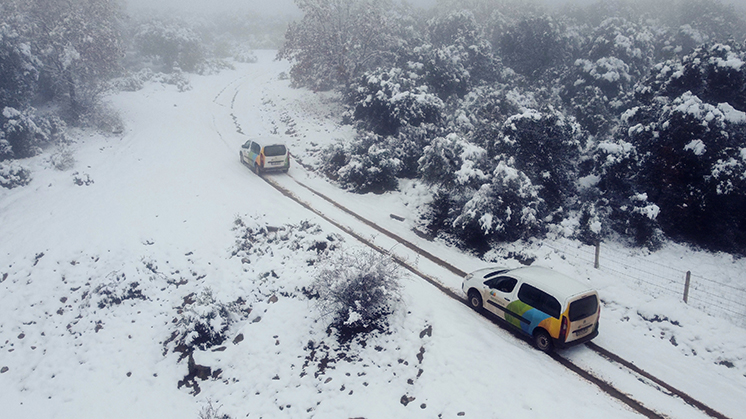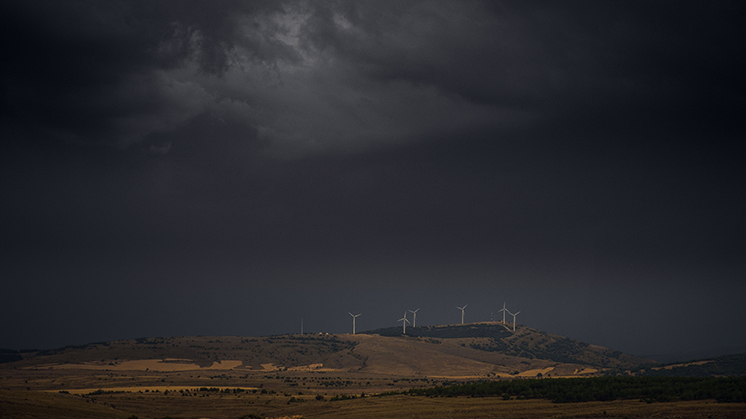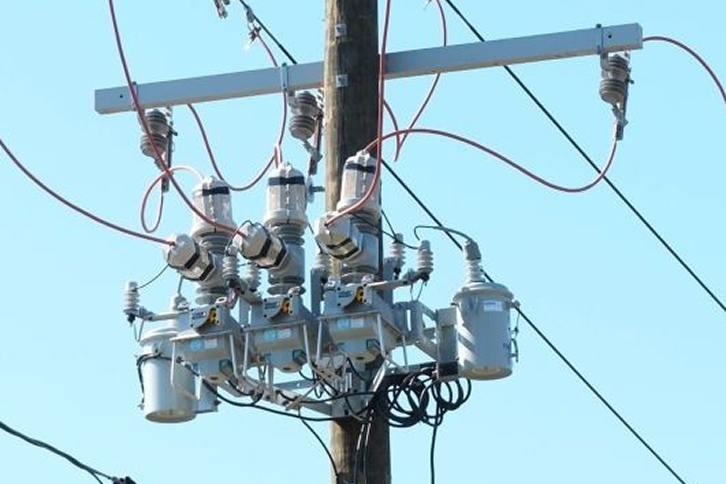Climate resilience
Iberdrola: anticipation, prediction and management to increase the climate resilience of its infrastructures
Power generation and distribution infrastructures may be directly affected by phenomena such as floods, storms or other extreme events whose frequency and intensity are expected to increase as a consequence of climate change in the coming years.

Restoration of the supply to the Island of Tabarca (Spain) after the storm.

Iberdrola staff at the Sierra de Dueña wind farm in Las Veguillas (Spain).

Storm at the Portelrubio wind farm (Spain).
Experts point to a trend of increasing adverse events due to the effects of climate change. At the same time, the use of electricity in society is becoming increasingly important to enable decarbonisation, making it necessary to integrate these future effects into the planning and operation of distribution networks. However, it should be noted that many of the impacts of climate change affect normal business variables that are already managed in operational processes.
The electricity transmission and distribution network: key to climate resilience
In the specific case of electricity transmission and distribution networks must be taken into account that they cover large distances, with overhead lines often crossing highly exposed areas.
In this context, the Iberdrola group, through i-DE Enlace externo, se abre en ventana nueva., its distribution company in Spain, has carried out a strategic analysis of the effects of climate change to detect which aspects of the distribution grid may be affected. According to this study, the main impacts detected by the increase in extreme events are:
Enlace externo, se abre en ventana nueva., its distribution company in Spain, has carried out a strategic analysis of the effects of climate change to detect which aspects of the distribution grid may be affected. According to this study, the main impacts detected by the increase in extreme events are:


The trend towards an increase in extreme temperatures and land desiccation, which increases the number of fires and the difficulty of controlling them.
In order to improve the resilience of electricity grids in the face of the greater frequency and severity of these events, the company has invested heavily in recent years to transform its grids into smart grids, with greater digitalisation and automation, which are more reliable and secure, enabling it to improve its response to incidents, both in terms of the number of customers affected and the duration of these outages. As a result, in 2021 alone, Iberdrola reduced the duration of these outages in Spain by 16%, reaching the best year-end value in its history.
Thanks to these investments, which have totalled 1.6 billion euros in Spain over the last three years despite the limitations and challenges posed by the pandemic, the company has been able to cope with events such as the DANA storm recorded in the Spanish Levante region in September 2019, after which Iberdrola was able to restore service in less than three minutes to 65% of its customers and in one hour to 80%.
Another more recent case is the response during the Filomena storm, an unprecedented snowstorm that caused numerous incidents in Iberdrola's distribution network, mainly in the centre of Spain. In 70% of these, Iberdrola was able to restore supply in less than 30 minutes, thanks to grid automation and automatic supply replenishment developments.
More challenges and recognition of good practices
Iberdrola's distributor in northeast Brazil, Neoenergia Cosern Enlace externo, se abre en ventana nueva., has been recognised by the National Electricity Agency (Aneel) as the best performing large distribution network operator in 2021. Neoenergia Cosern's 1.4 million customers had uninterrupted electricity supply for 99.98% of the 8,760 total hours of the year.
Enlace externo, se abre en ventana nueva., has been recognised by the National Electricity Agency (Aneel) as the best performing large distribution network operator in 2021. Neoenergia Cosern's 1.4 million customers had uninterrupted electricity supply for 99.98% of the 8,760 total hours of the year.
On the other hand, SP Energy Networks, Iberdrola's UK business, faced a series of severe storms that affected its territory during the last months of 2021. Thanks to its extensive capacity and experience in dealing with these scenarios, it was the first company to restore full service to the 200,000 customers affected: 89% were restored in less than 24 hours and 96% in less than 48 hours.
The Iberdrola group's distributors in the United States -CMP, NYSEG Enlace externo, se abre en ventana nueva. , RG&E
Enlace externo, se abre en ventana nueva. , RG&E  Enlace externo, se abre en ventana nueva. and UI- have been recognised by the Edison Electric Institute (EEI) for their capacity to respond to the devastation caused by Hurricane Ida in Louisiana in 2021 and by the storms that affected various areas of the country at the end of 2019 and 2020. The mobilised teams worked to restore power as quickly as possible, ensuring the safety and quality of service delivered to customers.
Enlace externo, se abre en ventana nueva. and UI- have been recognised by the Edison Electric Institute (EEI) for their capacity to respond to the devastation caused by Hurricane Ida in Louisiana in 2021 and by the storms that affected various areas of the country at the end of 2019 and 2020. The mobilised teams worked to restore power as quickly as possible, ensuring the safety and quality of service delivered to customers.
Main actions in the electricity grid for climate resilience
In addition to transforming the grids into a smart infrastructure, Iberdrola is carrying out other actions in its electricity grids to improve their climate resilience globally:
Burying of overhead networks in areas with historical extreme events in recent years or which, due to their geographical location, are at greater risk of suffering any of the impacts described above.
Increase in the degree of automation of the medium-voltage network, thereby improving the time taken to identify, isolate and repair incidents.
Improved maintenance and pruning plans for vegetation under overhead lines.
Emergency management and early warning systems. For example, with the use of drones and LIDAR inspection systems, through laser beams.
Other actions aimed at improving the design of installations, such as the application of new materials that withstand high temperatures or substation and transformer station designs that can maintain service in the event of flooding and fire.
Predictive and anticipatory systems for adverse atmospheric events
In the face of climate change, in addition to actions aimed at resilience, predictive and anticipatory systems are also essential. In this regard, Iberdrola has an advanced computer system, Meteoflow, the main purpose of which is to predict the electricity production of renewable facilities in different countries, and which has been incorporating other functionalities in recent years.
Among them, its capacity to forecast meteorological phenomena stands out. A recent example of its application and continuous improvement was the response to the Filomena storm. Thanks to the incorporation of the ice generation alarm, it was possible to act in advance, mobilising personnel in advance, pre-locating generators and using drones and helicopters.
In addition to the Meteoflow system, the internal Domina tool also stands out, which allows the periodic monitoring of the operation of the systems. These tools make it possible to anticipate failures, improve response capacity and, in general, carry out less costly repairs.
In the field of renewables, in addition to the specific site studies and design criteria that are normally applied, in certain geographies the systems must be designed to deal with extreme events such as hurricanes, storms with high electrical loads, snow and ice storms, flood and flood forecasting and management in rivers and reservoirs, etc.
The evolution of technology has made it possible today to have designs that can adapt to these new conditions that are becoming more and more frequent in certain locations. For example, wind turbines are designed and certified for hurricanes and typhoons under specific class conditions, known as the Typhoon class, which focuses on designs capable of structurally protecting wind turbines against these events .
In addition to the foregoing, the Iberdrola group has internal procedures and policies that generally contribute to the resilience of its facilities.





